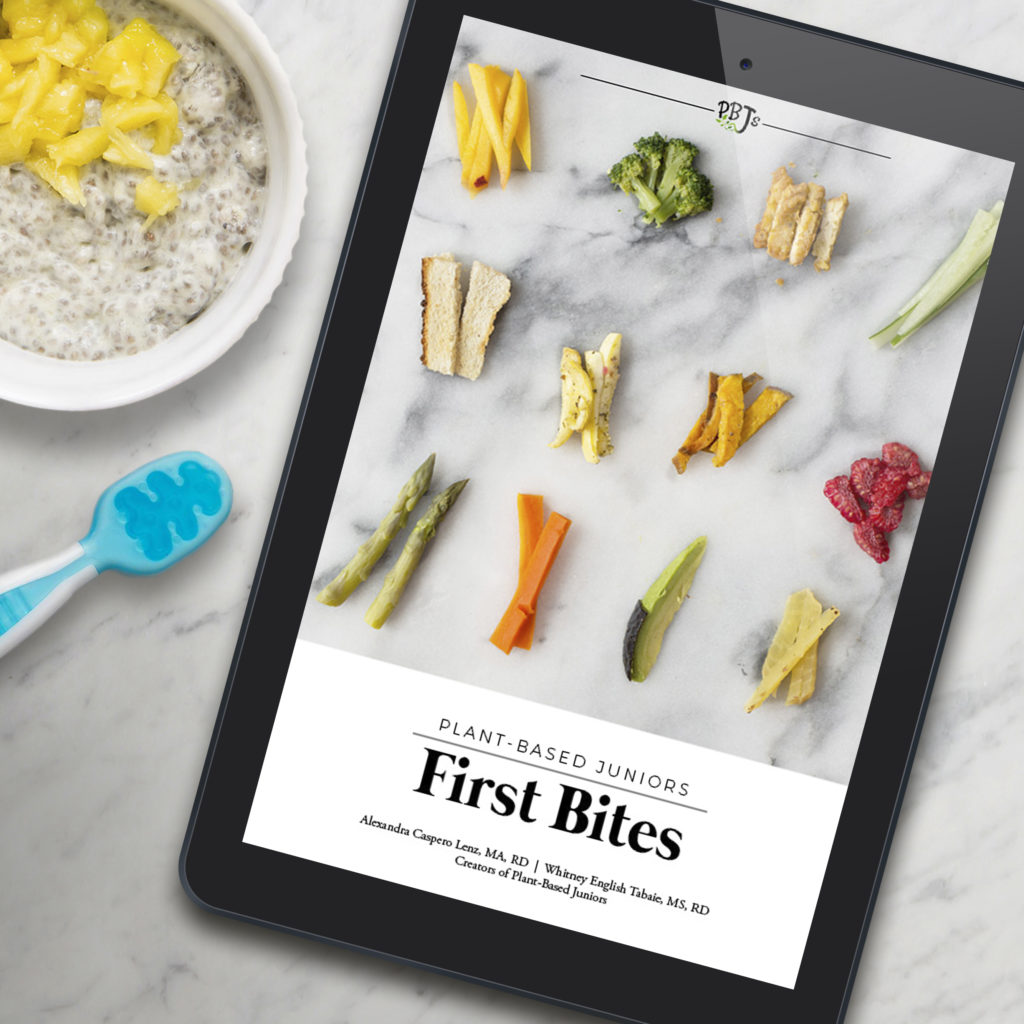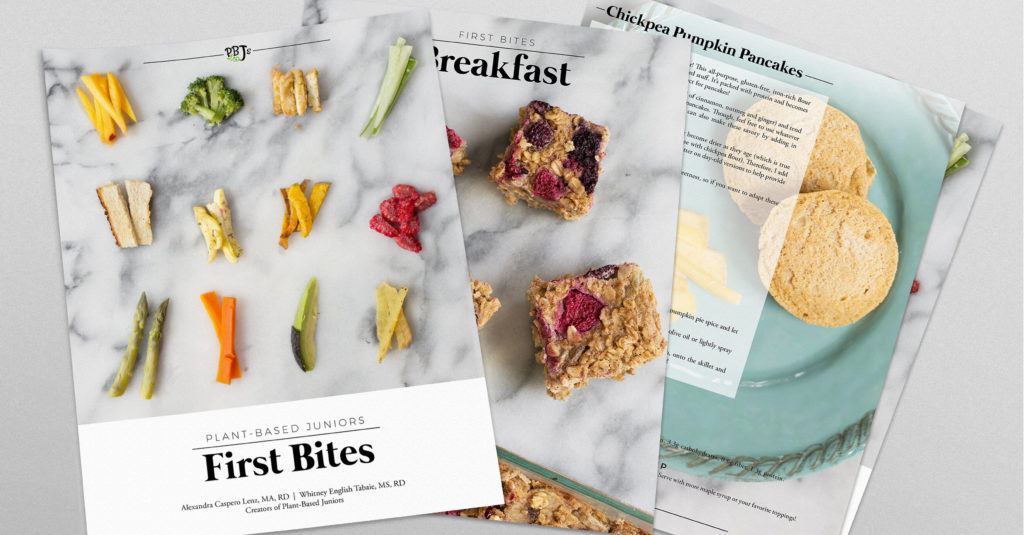Five Tips For Babies To Eat Real Food
It’s almost time for real food! Given that it’s been 6 years since I’ve fed a baby solids, I figured a refresher from the pros would be appropriate. Registered Dietitians moms Whitney and Alex created a program called Plant-Based Juniors, and I’m sharing all the deets in today’s post.

+++
Hello! Let us introduce ourselves. We’re Whitney and Alex, Registered Dietitians, moms and co-creators of Plant-Based Juniors. We’re also big fans of KERF and excited to chat with you about one of our favorite subjects – introducing more vegetables in infancy.
 VIDEOS
VIDEOS
While we’re both “predominantly plant-based” eaters ourselves, our mission is to get more plants on the table – regardless of what else you’re serving! After seeing private clients for the past decade, we believe that most of us could use a few more plants in our diet, so why not begin that habit right from the start?!
As we both became moms in the last year, we know the struggles that come with deciding what (and how) to feed your children. It’s the reason that we started the Plant-Based Juniors community; a space to share evidence-based nutrition research on feeding littles and a judgement-free zone where we could help each other with all of the many decisions that come with raising healthy eaters.
Think of your baby’s palate like a blank canvas, easily shaped by each new taste and experience. As dietitians and parents, we’re focused on shaping that palate to enjoy all foods, especially nutrient-rich foods like vegetables.
Therefore, whatever approach to feeding you take, we recommend adding vegetables at almost every meal. Studies have shown that babies who eat a wide variety of vegetables during the first year of life go onto eat more vegetables than those that don’t. Sweet-tasting vegetables, like carrots and sweet potatoes might be accepted more than bitter-tasting vegetables but that’s OK. Continuing to offer vegetables in different ways helps improve acceptability.

Because this mission is so important to us, we wrote a book, Plant-Based Juniors: First Bites that guides parents in guiding baby toward a happy, healthy relationship with food. We provide you with a comprehensive guide to starting solids and answer all of the questions you may have along the way – from the first bite and beyond. We’ve also included 20 plant-based recipes that are perfect for infants.
To get started, here are 5 ways to incorporate vegetables in infancy
1.Vary your own diet
Breastfeeding? Then your diet may be just as important as baby’s. According to recent studies, babies are more likely to enjoy the foods their moms ate while breastfeeding over new foods they were never exposed to. If you are nursing, here’s one more reason to pile on the vegetables.
2. Add spice!
Yes, babies like flavor! We don’t know where the idea of bland baby-food came from, but it likely wasn’t from a baby! Season baby’s food the same way you would yours. All seasonings are on the table, except for salt, sugar and anything too spicy. Experimenting with different spice blends is a great way to expose your baby to new flavors.
3. Make superfood popsicles
We consider popsicles to be the perfect place for leftover smoothies and green juices – throw them into a popsicle mold, freeze and you’re done! Enjoy the recipe below for our Superfood Breastmilk Popsicles.
4. Offer them often
The key to acceptability? Making vegetables part of baby’s everyday routine. This is true for kids of all ages. The more they are exposed to veggies, the more they are willing to try them. We like to offer a vegetable in some form at every meal; it doesn’t need to be fancy – even steamed broccoli or finely-chopped spinach in scrambled eggs works!
5. Try it in a puree
We all know that kids love dips! If your baby is less than a year old, dollop the vegetable dip onto steamed vegetable fingers or spread a thin layer on toast. For older kids, offer the dip alongside items you know they will eat. Almost any vegetable dip works. We like blending spinach, cooked beets or steamed carrots into hummus or yogurt.
Superfood Breast Milk Popsicles
Ingredients
- 1/3 cup water or breast milk
- ½ cup chopped greens of choice try spinach, arugula, kale
- ½ cup chopped fruit of choice try peach, apple, pear, berries
- 1 teaspoon fresh squeezed lime or lemon juice
Instructions
-
1. Puree all ingredients in a high-powered blender or food processor until smooth.
-
2. Strain, using a fine mesh strainer. This step is optional, but provides a smoother
-
texture when using heartier greens or fruits with peels.
-
3. Pour into popsicle molds, cover and freeze until hardened, about 3-4 hours.
-
While there are several popsicle molds on the market, we are partial to Nuby Garden
-
Fresh molds as the curved handle is perfect for babies learning to grasp.
If you’re a mom in the throws of it like Kath, the Plant-Based Juniors: First Bites book will get you off to a great start. The ebook includes:
- a nutrition guide for your #plantbasedbaby
- 20 easy + delicious recipes for baby that can be easily adapted for the whole family!
- step-by-step instructions on baby-led weaning
- tips for meal prep
- a grocery list
- a baby-led weaning FAQ section
- an RD-approved products list
For tasty, easy recipes for kids, check it out: Plant-Based Juniors: First Bites!
+++

Feeding a baby as healthy as possible was more challenging than I thought it would be, but it wasn’t hard. Here are some of my old posts about Mazen eating real food.
from Kath Eats Real Food https://ift.tt/2EflDZ6
Comments
Post a Comment